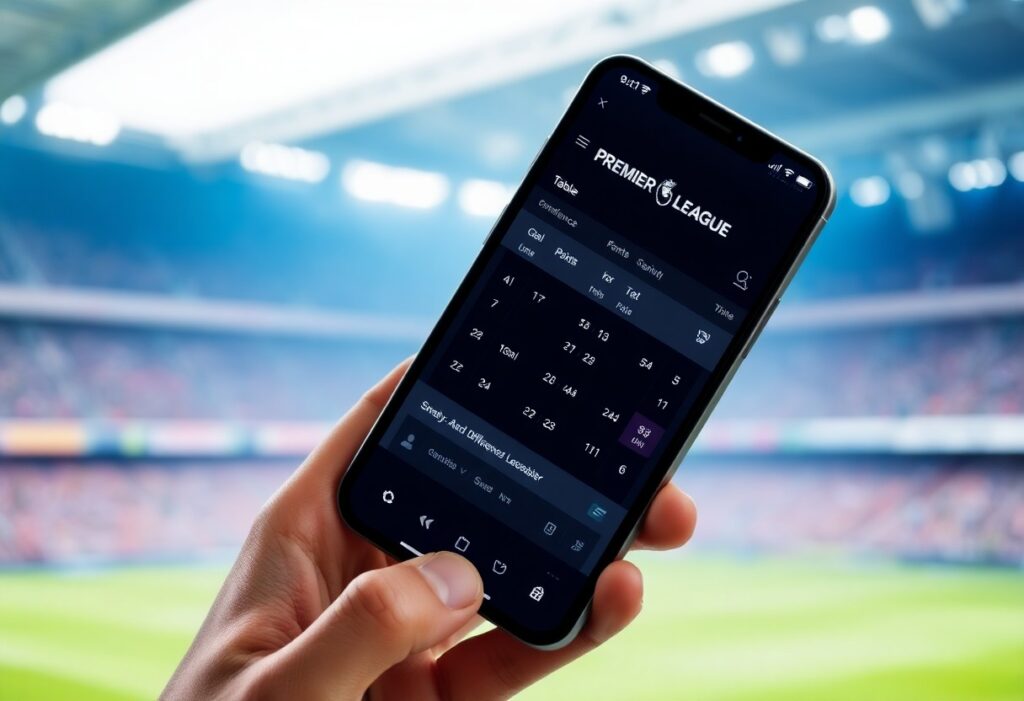
Standings in the Premier League are more than just numbers; they represent the competitive landscape of English football. Each team earns three points for a win, one point for a draw, and none for a loss, shaping their journey towards the coveted championship. When teams are tied on points, goal difference becomes the primary factor for ranking, emphasizing the importance of not just winning but winning decisively. This guide will clarify how points, goal difference, and tiebreakers work, enhancing your understanding of the league’s dynamics.
Understanding Points
The Premier League operates on a straightforward points system where teams earn points based on their match performance. A victory awards teams three points, a draw grants each team one point, and a loss yields no points. This system rewards winning while still acknowledging the value of drawing, leading to a competitive league structure that strives to minimize the impact of losses.
Winning, Drawing, and Losing
Winning, drawing, and losing match outcomes directly influence a team’s standing in the Premier League table. Teams with the highest number of wins rank highest, while draws and losses can significantly affect their position. Teams that consistently secure victories not only boost their points but also build morale and influence brand strength in the league.
In the Premier League, the importance of winning cannot be overstated, as teams accumulate points primarily through victories. For example, a team that wins 20 matches in a season will earn an impressive 60 points, provided they don’t draw or lose excessively. However, teams that find themselves frequently drawing games, such as 10 draws in a season, would still benefit from these points, totalling 10 points, but may struggle against contenders who hug the top with more wins. Therefore, balancing strategies between winning and securing draws is important for overall league survival and success.
Goal Difference Explained
Goal difference serves as a vital metric in determining team standings when points are tied. It reflects the overall scoring ability and defensive strength of a team, ultimately impacting their position in the league. Since the Premier League often sees teams finish on equal points, goal difference becomes a decisive factor in ranking.
What is Goal Difference?
Goal difference is calculated by subtracting the total goals conceded from the total goals scored by a team throughout the season. A positive goal difference indicates more goals scored than conceded, while a negative figure highlights defensive weaknesses.
Calculating Goal Difference
To calculate goal difference, simply use the formula: Goals Scored – Goals Conceded. For example, if a team scores 50 goals and concedes 30, their goal difference is +20. This numerical value contributes to their cumulative point total and can be a decisive factor in league standings.
In the Premier League, the significance of goal difference cannot be overstated. For instance, during the 2018-2019 season, Manchester City and Liverpool finished with identical points, but City secured the title with a goal difference of +76 compared to Liverpool’s +52. Such instances highlight the importance teams must place on not only winning but also on the margins of victory versus their opponents, as each goal positioned them strategically in the league framework.
Tiebreakers: When Points and Goal Difference Are Equal
In the highly competitive Premier League, teams may find themselves tied on points and goal difference, which necessitates the use of tiebreakers to determine their position on the table. The league has established clear criteria to resolve such situations, ensuring a fair outcome in ranking teams that perform equally well throughout the season.
Head-to-Head Results
When teams are level on points and goal difference, the first tiebreaker takes into account their head-to-head results. This involves comparing the outcomes of the matches played between the two tied teams, focusing on points earned in these encounters. A team with more points from these matches will be placed higher in the table.
Goals Scored
If head-to-head results do not differentiate the teams, the next tiebreaker is total goals scored during the season. This aggregate figure gives precedence to the team demonstrating superior offensive capabilities and overall contribution to the league’s entertainment value.
In practice, this means that even if a team has secured the same number of points and has an identical goal difference, an impressive scoring record can provide an edge. For example, if Team A and Team B finish the season with 75 points and a goal difference of +30 each, but Team A has scored 80 goals compared to Team B’s 75, Team A will occupy the higher position in the table. Such details can have significant implications for qualification spots in European competitions or relegation battles.
Factors Influencing Team Performance
Several factors significantly affect a team’s performance in the Premier League, impacting their overall standings and success throughout the season. Key elements include team form, injuries, managerial decisions, and team dynamics. A team’s ability to adapt to these variables often determines its resilience and success in the league. This can lead to fluctuating performances, making consistent results difficult to achieve.
- team form
- injuries
- managerial decisions
- team dynamics
Form and Injuries
Team performance heavily relies on current form, which can be influenced by player injuries. A healthy squad often showcases consistency, while injuries can lead to disruptions in tactics and squad rotation. In the 2020-2021 season, for instance, Liverpool lost multiple key players to injuries, which severely affected their title challenge.
Managerial Decisions
Effective managerial decisions play a pivotal role in shaping team performance during the league. Managers are responsible for tactics, player selection, and game strategy, impacting both immediate results and long-term development. Teams like Manchester City have thrived under the tactical guidance of Pep Guardiola, showcasing how strategic insights can lead to dominant performances.
Beyond basic selections, managerial decisions include in-game tactics and adjustments based on opponents’ strengths and weaknesses. For example, how a manager chooses to utilize substitutes can alter a match’s outcome significantly. Effective use of analytics and understanding of player psychology allow managers to unlock players’ potential, making them necessary in navigating the demands of a long season. This strategic insight often elevates teams from good to great, contributing to championship runs or securing top-tier status in the league.
Tips for Following the Premier League Table
To effectively track the Premier League standings, consider the following tips:
- Regularly check the Premier League table on reliable sports websites.
- Follow live match updates and alerts for real-time score changes.
- Engage with fan forums and social media for insights on team performance.
- Stay informed about player injuries and transfers that could influence results.
The table is dynamic, reflecting the ongoing shifts in team standings.
Staying Updated on Matches
For true followers, keeping up with match results is important. Use sports apps or websites that provide live updates, scores, and lineups. Social media platforms are also helpful; many sports news accounts tweet real-time events during games, allowing fans to stay engaged without watching every match.
Understanding Team Trends
Identifying patterns in team performances can provide deeper insights into the league. By analyzing past matches, one can observe how teams respond to various factors such as home advantage, weather conditions, and injury patterns. For example, a team with a strong home record may consistently perform well in front of their fans, while a club that struggles away might lose crucial points. Additionally, examining player statistics and match outcomes over several weeks can reveal potential weaknesses or strengths that might not be immediately apparent, offering a greater understanding of their trajectory throughout the season.
Pros and Cons of the Current System
| Pros | Cons |
|---|---|
| Simple to understand and implement | Can lead to tiebreakers that may seem arbitrary |
| Encourages consistent performance over the season | Goal difference may not reflect true team quality |
| Rewards teams for not only winning but also scoring goals | Heavy reliance on goal difference can diminish some match importance |
| Promotes defensive strategies and tactics | Can result in conservative play late in the season |
| Fairly distributes points across the league | Makes it hard for teams with fewer matches to catch up |
| Provides a clear ranking system | Potential for misinterpretation of overall success |
| Encourages competitiveness throughout the league | Does not account for the quality of opponents faced |
| Maintains viewer interest in goal-scoring | Can lead to unfair advantages based on scoring history |
| Supports statistical analysis and fan engagement | May overlook individual player contributions |
| Tradition within the league | Limited adaptability for improving fairness |
Advantages of Points and Goal Difference
The points and goal difference system offers significant transparency in team rankings, promoting a straightforward competitive landscape. Teams earn three points for a win and one for a draw, creating a clear incentive for teams to perform optimally throughout the season. Additionally, goal difference acts as a practical tiebreaker, highlighting offensive prowess and defensive solidity, which can shape strategies and fan engagement. This system has fostered intense rivalries and a dynamic viewing experience, appealing to supporters and stakeholders alike.
Disadvantages and Alternatives
While the points and goal difference approach is prevalent, it has notable limitations. Teams with the same points can fall victim to ties decided by goal difference, which some argue is an inadequate marker of performance. Alternatives such as considering head-to-head results or a playoff system for tied teams could enhance fairness. However, changes may disrupt established traditions and viewer expectations, posing challenges in implementation and acceptance.
This dependence on goal difference, although practical, raises concerns about fairness. A team with a higher goal difference might have faced weaker opponents throughout the season, skewing the results. Alternatives, such as implementing head-to-head performance as a tiebreaker, could address this issue by rewarding direct competition outcomes. Moreover, exploring playoff systems might add excitement by allowing teams to compete again even after finishing tied, encouraging a more dynamic conclusion to the season. Adopting such strategies could require significant shifts in league structure and fan engagement, presenting its own set of challenges.
To wrap up
Upon reflecting, comprehending the Premier League table involves recognizing the importance of points, goal difference, and tiebreakers in determining team standings. Points are awarded based on match outcomes, while goal difference serves to differentiate teams that may have identical points. Understanding the hierarchy of tiebreakers, including goals scored and head-to-head results, provides clarity on how teams are ranked in this competitive league. This knowledge is necessary for fans and analysts alike, fostering a deeper appreciation of the league’s structure and the intricacies that impact team performances throughout the season.
FAQ
Q: How is the Premier League table structured?
A: The Premier League table is organized based on points accumulated by each team throughout the season. Teams earn 3 points for a win, 1 point for a draw, and 0 points for a loss. The table is ranked with the team having the highest points at the top.
Q: What role does goal difference play in the Premier League standings?
A: Goal difference is used as a tiebreaker when two or more teams have the same number of points. It is calculated by subtracting the total number of goals conceded from the total number of goals scored. A higher goal difference indicates a better performance in terms of scoring relative to conceding.
Q: What tiebreakers are used if teams have the same points and goal difference?
A: If teams are tied on both points and goal difference, the next tiebreaker is the total number of goals scored throughout the season. If teams are still tied after this, the results of head-to-head matches between the teams in question may be considered to determine their ranking.


